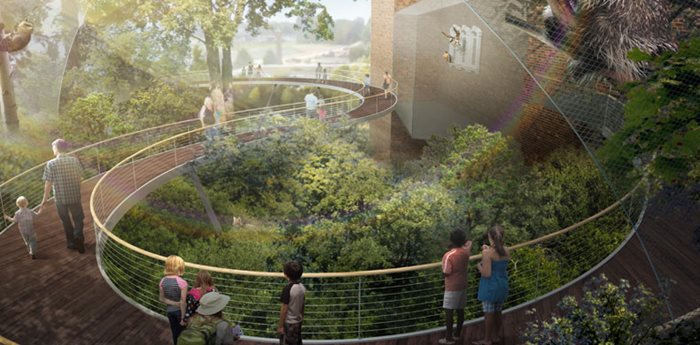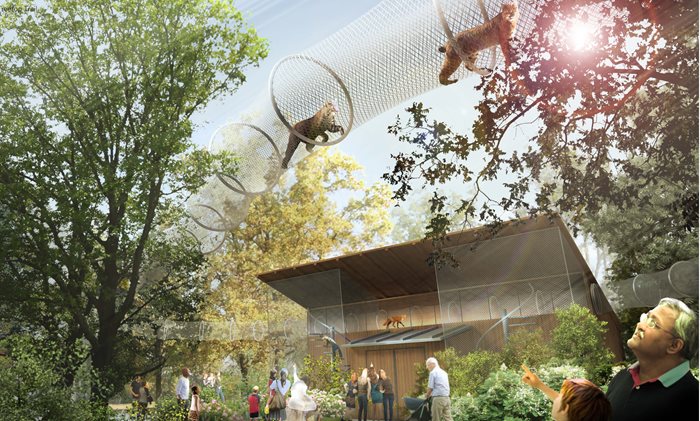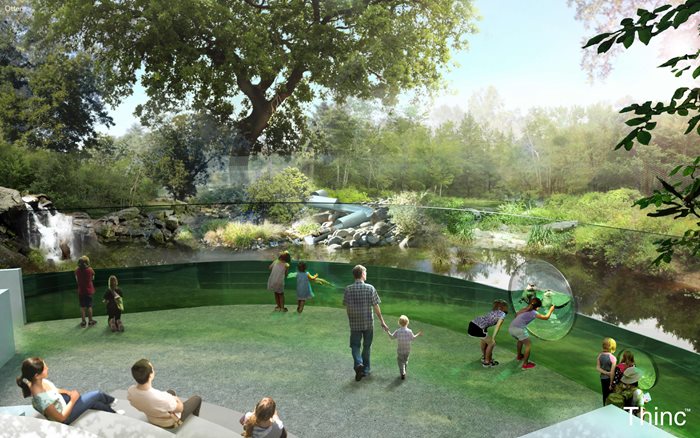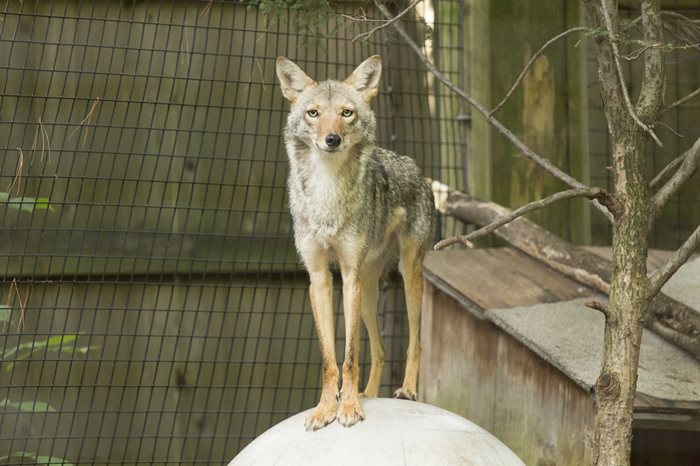June 15, 2015
Blog by David Beach
Staff - Cleveland Museum of Natural History
Director of
GreenCityBlueLake Institute
As they fly, swim and climb, wild animals live in three dimensions. And the human visitors of the Cleveland Museum of Natural History will soon be able to share this experience in exciting new ways.
The Museum broke ground for construction of a new
Perkins Wildlife Center & Woods Garden today. The popular outdoor collection of native Ohio plants and animals will be moved from its current location to the opposite side of the Museum campus. The new site includes a steep hillside and ravine, and the new exhibits are being designed to take advantage of the sloping topography.
When the new Perkins opens next year, you will enter on an elevated walkway through the tree canopy. Raccoons will be climbing in the trees. You will pass through an aviary full of songbirds, waterfowl, and upland game birds. Then you will be level with bobcats jumping on rock ledges.

Further on, the path will descend into a pond, and you will be eye to eye—separated by a curving, 50-foot-long wall of clear acrylic—with river otters swimming underwater. Then you will cut through a vertical cross section of a wetland, the home of Sandhill Cranes. Above the wetland habitat, as in nature, you will see Bald Eagles.
“The creative use of topography will create compelling experiences for both visitors and wildlife,” says Harvey Webster, director of the Museum’s Wildlife Resources Division.
Perkins’ bobcats, foxes, raccoons and coyote will have an additional means of going vertical -- an overhead trailway system which will allow them to leave their enclosures and roam around the site.

“We think this will be a transformational experience for the animals,” Webster says. “It will increase enrichment opportunities and will put us in the company of the most forward-thinking zoos.”
He adds that
#Perkins2016 will be built to the accreditation standards of the Association of Zoos and Aquariums. This will mean more space for animals. And it also will mean better facilities for animal care, such as expanded veterinary space, quarantine area for new animals, and more heated buildings to shelter animals in extremely cold weather.
The animals in Perkins, representing some 40 species, are all rescue animals that cannot survive in the wild. Many of the species—river otters, Bald Eagles, Peregrine Falcons, bobcat, snowshoe hare, and coyote—were once endangered or extirpated from Ohio but have now recovered to varying degrees. Otters, for example, were extirpated from the state by the early 1900s, a casualty of over hunting, deforestation and other sources of water pollution that silted in rivers and made the water too polluted for these aquatic mammals. By 1986, however, many streams had improved enough for the Ohio Department of Natural Resource to reintroduce otters. Now they can be found in two-thirds of the counties in the state.

“The story of the river otter shows how we can work together to affect the recovery of endangered species,” Webster says. “Our animals are great ambassadors for building appreciation for nature. And appreciation is the basis for forming a conservation ethic.”
Increasingly, wildlife is moving back into urban locations, so Perkins is an introduction to what might be in your backyard.
“Often people don’t know these animals, or they misunderstand them,” says Michelle Leighty Jones, manager of Wildlife Resources. “For example, some people say they don’t like coyotes. But when they see our coyote, Charcoal, they realize how smart and playful and fun she is. And that helps change their perception. So Perkins promotes a sense of caring for the wild animals living around us.”

The animals of Perkins perform multiple educational duties—within Perkins and as the stars of live animal shows in the Museum and throughout Northeast Ohio. Webster calls the animals “the hardest working collection at the Museum.”
The existing Perkins Wildlife Center & Woods Garden will close this August. During the coming year of construction some of the animals will remain on view in temporary quarters in the Museum’s Thelma & Kent H. Smith Environmental Courtyard. Then look for novel encounters with all the animals when the new Perkins opens to the public in summer 2016.
Learn about the Museum's
Centennial Campaign or see more recent
blog posts.